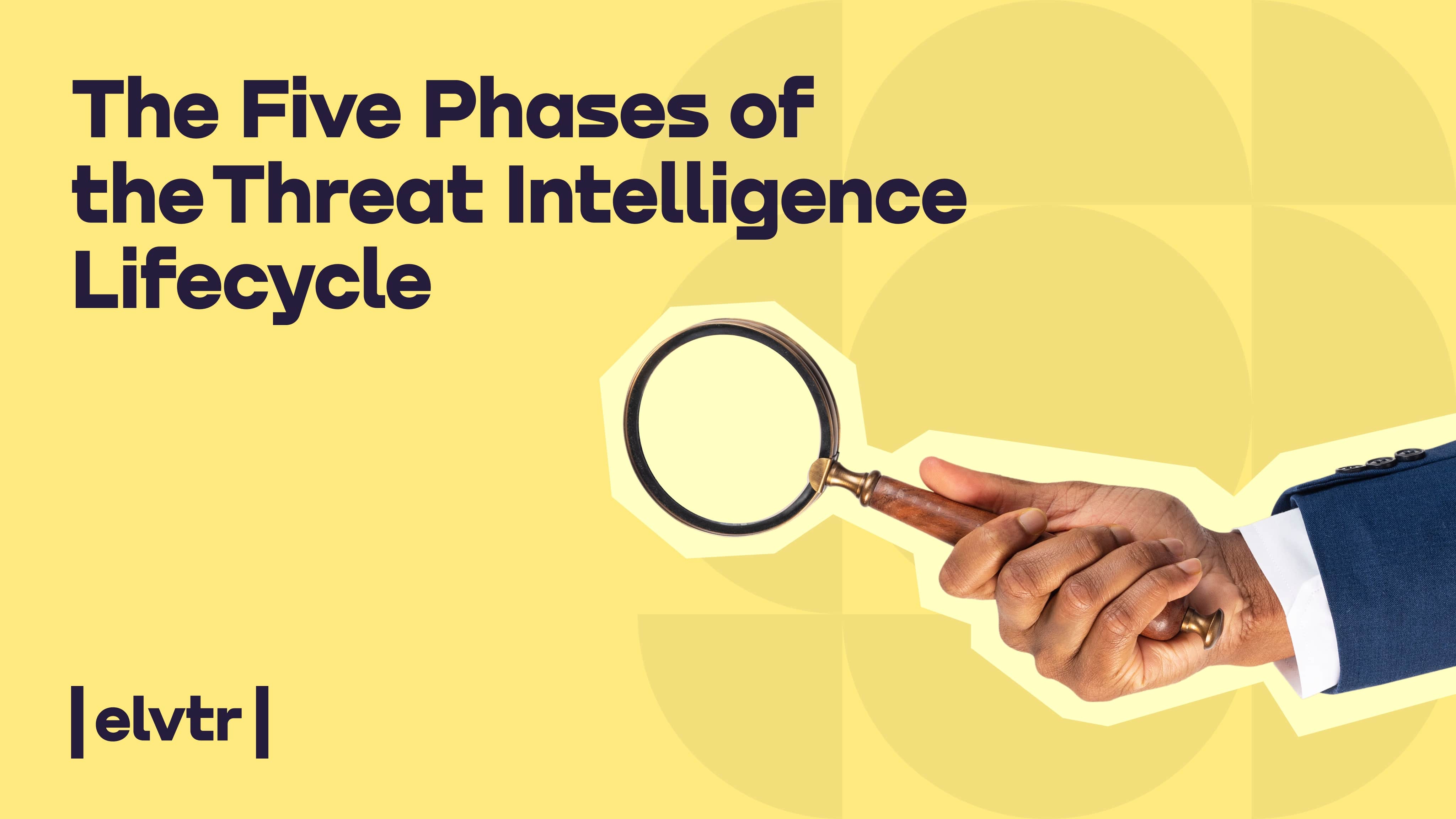- MAIN PAGE
- – elvtr magazine – THE FIVE PHASES OF THE THREAT INTELLIGENCE LIFECYCLE
THE FIVE PHASES OF THE THREAT INTELLIGENCE LIFECYCLE

Well, that's where the Threat Intelligence Lifecycle comes into play. Think of it as a strategic process that helps organizations gather, analyze, and act upon valuable insights to combat potential risks. This is a popular practice to enhance their ability to protect the systems, data, and assets from cyberattacks.
Here are the 5 phases of the threat intelligence lifecycle:
- Planning. Organizations define their objectives and goals for threat intelligence. They outline what threats they want to monitor and how to use the information.
- Collection. Data is gathered from various sources, both internal and external.
- Processing. The collected data is organized and analyzed to identify indicators of compromise, suspicious activities, or emerging threats.
- Analysis. The processed information is examined to understand the context, patterns, and potential impacts of the threats.
- Dissemination. The analyzed intelligence is shared with relevant stakeholders.
Below, we will discuss the steps in more detail and explain their roles in organizations’ cybersecurity. So, if you're intrigued by the inner workings of threat intelligence and want to explore the fascinating world of cybersecurity, join us on this journey through the Threat Intelligence Lifecycle. Together, we'll uncover the secrets to staying one step ahead of cyber threats and safeguarding digital assets.
1. Planning
Let's break down the first step of the Threat Intelligence Lifecycle. It all starts with a solid plan that guides you toward a safer digital future.
Think of it as laying the groundwork for your mission against cyber threats. This step involves setting clear objectives and defining the scope of your intelligence efforts. You'll ask yourself important questions like:
- What specific threats are we targeting?
- What are our priorities?
- What resources do we need
It's like creating a battle plan before heading into the field. By carefully planning your approach, you can ensure that your efforts are focused, efficient, and aligned with your organization's goals.
During the planning phase, organizations take the time to assess their intelligence requirements. They figure out the specific types of threats and information they need to tackle to achieve their objectives. This crucial step ensures that the intelligence collected is focused, relevant, and ready for action.
Resource allocation is another key consideration in the planning process. Organizations assign dedicated personnel responsible for gathering, analyzing, and sharing intelligence. They may also allocate budgets for essential tools, technologies, and external services to ensure the threat intelligence program operates smoothly and effectively. By strategically planning the allocation of resources, organizations can optimize their efforts in combating threats and safeguarding their digital landscape.
2. Collection
In the collection phase, the hunt for valuable information begins. Organizations use both internal and external data collection strategies. Internally, they tap into their network logs, system event logs, security devices, and incident reports. They aim to gain insights into their infrastructure and potential indicators of compromise (IOCs).
When it comes to expanding their knowledge of the threat landscape, organizations don't just rely on their internal resources. These sources include threat intelligence feeds, open-source intelligence, security blogs, forums, social media, and industry-specific platforms. By accessing external data, organizations gain broader insights into emerging threats, known attack techniques, and the activities of threat actors.
Now, let's talk about the data they collect. It comes in two flavors: structured and unstructured. The structured data consists of specific indicators or hashes tied to known threats. On the other hand, unstructured data includes reports, articles, and blogs that hold valuable insights about potential risks.
But here's the cool part: Automation and specialized tools make the collection phase even more efficient. These tools automatically gather data from multiple sources, apply filters and analysis techniques, and even flag potential threats.
Recommended courses
3. Processing
In the processing stage, organizations take their collected raw data and give it a meaningful makeover, transforming it into actionable intelligence. This is where the real magic happens, as several key activities come into play:
- Data normalization is a crucial step where the collected data is standardized and organized. This ensures consistency, making it easier to analyze and compare different points.
- Data enrichment involves adding additional context and details to the collected data. This can include enriching indicators of compromise (IOCs) with more information about associated threat actors, attack patterns, or affected systems.
- During correlation and aggregation, the processed data is analyzed to identify relationships, patterns, and connections between different indicators. This step helps reveal a full picture of the threat landscape so that organizations can detect overarching trends or coordinated attacks.
- Contextualization is the process of considering factors such as the organization's industry, geographic location, and specific systems or assets. By contextualizing intelligence, organizations can prioritize threats based on their relevance and potential impact.
- Triage and filtering involve refining the processed data using filters and prioritization criteria. This helps remove noise, false positives, or irrelevant information.
- Classification and tagging categorize the processed intelligence. It's like labeling different types of intelligence based on predefined categories or taxonomy. This helps organize and retrieve specific types of intelligence when needed.
- Timeliness assessment evaluates the freshness and relevance of the processed intelligence. Timely information is critical for effective threat response, allowing organizations to prioritize immediate actions and allocate resources.
4. Analysis
The fourth step in the Threat Intelligence Lifecycle is analysis. This is where the experts dive deep into the processed intelligence, examining it for patterns, trends, and relationships. Their goal? To understand the nature and scope of the threats.
During analysis, analysts identify the tactics, techniques, and procedures (TTPs) employed by malicious threat actors. By getting inside their heads, organizations can stay one step ahead, anticipating potential attacks and fortifying their defenses.
But it doesn't stop there. Experts also assess the potential impact of threats on the organization's assets, operations, and overall security posture. They weigh the likelihood of an attack occurring and consider the potential consequences, such as financial strain, damage to reputation, or disruption to operations.
In the analysis phase, any intelligence gaps or areas needing additional information are identified. Analysts may recommend further research or specific data sources to gather missing details. It's all about refining intelligence and ironing out any limitations in knowledge.
Ultimately, the analysis phase generates actionable recommendations. Analysts provide guidance on mitigating threats, improving security controls, or implementing cybersecurity strategies. Their insights become the roadmap to a safer and more resilient organization.
5. Dissemination
In this phase, organizations share the analyzed intelligence with stakeholders to drive decision-making and threat mitigation. This means reaching out to executives, security teams, IT personnel, and other key players in security and risk management.
The intelligence is shared in an easily understandable and accessible format. It could take the form of reports, briefings, threat bulletins, or interactive dashboards. The goal is to inform stakeholders about potential threats, help them grasp the impact, and guide their strategic choices.
Of course, not all intelligence is created equal. It's tailored to suit the specific needs of different recipients. Executives may receive executive summaries and strategic recommendations. Technical teams may get their hands on detailed indicators or action plans for implementing security measures.
But the sharing doesn't stop within the organization. Intelligence may also reach beyond the company walls, extending to trusted partners, industry peers, and relevant threat intelligence-sharing communities. This collaborative effort strengthens the collective defense against threats and enhances organizations' overall security posture.
By embracing the Threat Intelligence Lifecycle, organizations bridge the gap between raw data and actionable intelligence. It empowers them to detect, prevent, and mitigate security threats effectively. This strategic approach boosts their cybersecurity defense and equips them to adapt to emerging threats.
The Threat Intelligence Lifecycle is a powerful tool that enables organizations to protect their digital assets, maintain business continuity, and guard their reputation.

